The end of the year is looking a lot brighter for investors than it did at the start, with gains in stock indexes as well as most commodities accelerating in the second half. As we come to the end of the year, fund managers and other large institutional participants may look to take some money off the table. A weak holiday shopping season could provide an excuse, but longer-term bullish trends (especially in gold) appear intact.
The S&P has rallied more than 60 percent off its March lows under 700, crude oil started the year under $40 a barrel and is trading above $75 in early December, and gold continues to shatter records, trading above $1,200 an ounce, after starting the year near $800. One of the big concerns for this month is whether consumers will step up this holiday season and keep the party going. Consumer spending accounts for about-two thirds of U.S. GDP, so it’s an important part of the recovery story. If we are going to have a lasting recovery, we need consumers to spend. That could be tough if the job market doesn’t improve.
It could be a difficult holiday season for retailers. On December 1, Nielsen reported that 42 percent of U.S. consumers plan to spend less on holiday gifts in 2009. In consumable categories, Nielsen predicts that holiday sales will be flat, while the National Retail Federation predicts sales will fall 1 percent this year.
Stock Indexes
I think right now, stock indexes are looking rather top heavy. Technical indicators are signaling it might be time to be a little cautious. The Relative Strength Index (RSI) for S&P 500 futures is turning lower. We had a few fake outs, but the market keeps bouncing back up when coming close to the 10-day moving average, and has stayed above the 20-day moving average. A close under the 20-day moving average (now around 1,037) should bring a meaningful correction. For this month, I recommend buying dips down to 1,025 – 1,050.
Interest rates are also an important theme this month, as we have a variety of central bank policy meetings in December. I don’t think the Federal Reserve will do anything with interest rates until next year, and I don’t expect much change in their verbiage at the December 15-16 policy meeting. We should see the status quo in terms of a near-zero interest rate environment.
On Thursday, December 3, the European Central Bank also decided to keep its key lending rate steady at 1 percent. On December 1, the Bank of Japan held an emergency meeting, keeping its key overnight lending rate at 0.1 percent, but also set up new stimulus measures, including a 10 trillion yen lending facility. BOJ Governor Masaaki Shirakawa said “if there is a shortage of liquidity, we are prepared to provide more funds.”
Before we see a change in interest rates in the U.S., I think we have to stop hemorrhaging jobs—we have to see non-farm payrolls at least at unchanged. On a positive note, the latest “Beige Book” report, the Federal Reserve’s analysis of the economy in general, was probably the most upbeat in eight months. The Fed said the economy “improved modestly” from October to mid-November; eight of the 12 Fed regions indicated conditions were better.
Despite signs of economic improvement, I think the stock market may have gotten a little ahead of itself. I’m looking for a sell-off in December, although that might seem a bit contrarian at this time of year. Keep in mind, September and October are typically negative months for the stock market, and weren’t this year. The big funds active in the market have made a lot of money, and some year-end profit-taking could ensue. The last two weeks in December, there is a high probability they will take some money off the table.
S&5 500 Futures
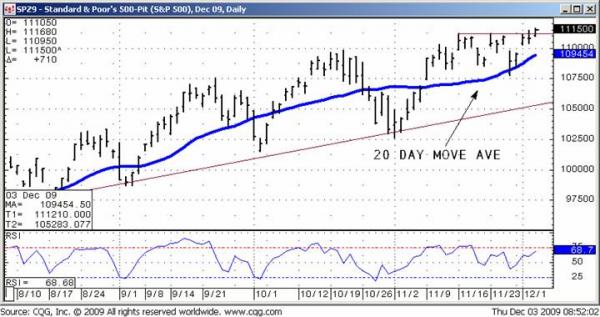
Dollar and Gold
The carry trade is still alive and well, and it’s clear the dollar is in a downtrend. The ICE Dollar Index futures need a close over 76 or 76.50 in the December contract to change the trend at all. The dollar’s weakness has been the big driver of commodities. Until interest rate policy changes, these trends aren’t likely to change significantly. And as mentioned, I don’t see any big shifts in December.
Dollar Index Futures

Gold is the darling of “big money” at the moment–countries, hedge funds, central banks, mining companies and other large investors. I think gold is way overbought, but I’m not fighting the trend. We have a huge momentum trade going on. There are three reasons investors have been bullish gold: inflation fears, as a currency hedge against the dollar, and as a safe-haven in times of distress. This three-pronged trade should keep the gold uptrend going into 2010.
Recently, investors haven’t been buying gold as a safe haven, they have been buying it as a hedge against the dollar. We saw India’s central bank purchase some $6.7 billion in gold from the International Monetary Fund in November, and China could be buying gold too as a hedge against the dollar.
While the fundamentals support gold, that doesn’t mean it will go straight up. There will likely be some corrections. Gold is a currency hedge but has also moved with investors’ risk appetites. The problems in Dubai, announced over the U.S. Thanksgiving holiday weekend, inspired a flight to the U.S. dollar, and out of stocks, as well as gold and crude oil. If the stock market posts significant declines over several days, we could see gold sell off too. We saw that happen in the first quarter of 2009, when stocks and commodities (including gold) declined.
From a technical standpoint, the 10-week moving average in gold comes in at $1,072, and the market is now above $1,200. Conservative traders can consider buying dips near that average, and a break to $1,100 looks reasonable. Be patient. If you want to fade the gold rally, you might consider buying puts. I’m very bullish gold in the coming year, and I think we’ll see it reach $2,000 in 12 months’ time. If you see any good pullback this month—get on the train.
Gold Futures
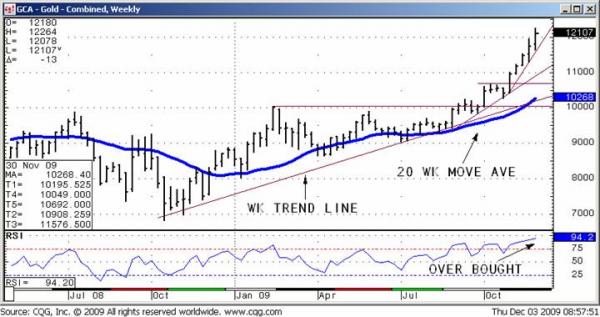
Crude Oil and Natural Gas
The January crude oil contract is showing a bull market on a weekly chart, but on a daily chart, it looks like it’s trending down. So I think your strategy for crude oil this month depends on your time horizon. Swing traders might consider playing a range; selling rallies up to $80 – $85, and buying on dips to $73 – $74. Position traders should wait for good support points to establish bullish positions.
In contrast to crude oil, natural gas has been in a strong bear market, one of the worst performing markets of 2009 amid a supply glut. We recently saw a short-covering rally in this market, then we saw a new low in the January contract. I think $4 to $4.20 per MMBtu could be a good place to buy. I would consider selling in the high $5 area, but a close above $5.50 would mark an upside breakout, and changes the picture.
Crude Oil Futures Daily
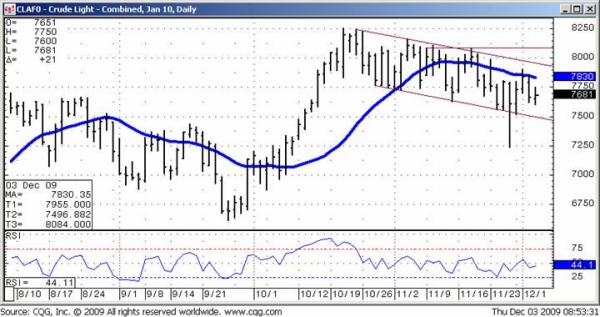
Crude Oil Futures Weekly
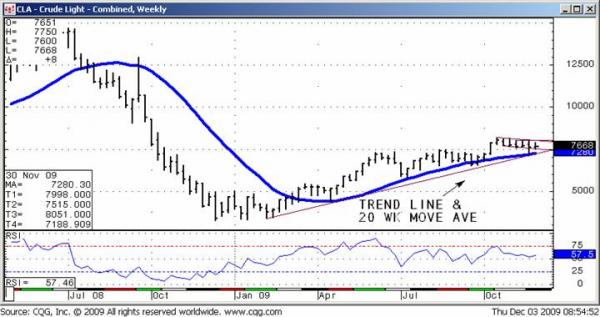
Soybeans and Corn
Last month, rain slowed harvest somewhat, but we should now have plenty coming out of the fields. On August 13, soybeans rallied to $10.68 a bushel, then sold off in the months following. The January soybean contract has recently retested those highs. The RSI is telling me that is market won’t likely push higher, and looks better to sell. If the market closes under $10.05, then I think soybeans will head to $9.70. If soybeans close below $10.20, we’d have an outside reversal on the weekly chart, a bearish signal. I think the short-term rally in soybeans has been exhausted but corn looks a bit better. Unless there are big buyers in December, I don’t see prices extending much further in soybeans.
The weekly chart of March corn futures shows a triangle formation. Go with it on a breakout; I think the market could head to $4.50 a bushel. A break under $3.74, last week’s low, would change the picture. The RSI is looking a bit shaky, so I wouldn’t buy corn outright but I think it has better prospects than soybeans right now.
A good strategy to consider in grains this month is a spread; buy corn and sell soybeans. You’d want to buy two corn contracts for one soybean contract to get the ratio correct.
Soybean Futures
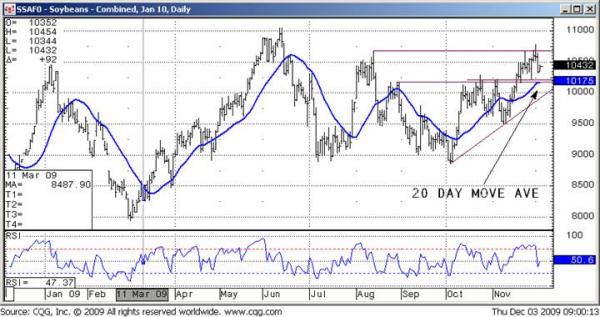
In sum, the economy seems to be chugging along, but it’s still a bit bumpy. I don’t think anything will change much for the markets in general in December as far as existing trends—other than perhaps some year-end profit-taking.
These are just a few of my thoughts and ideas for the month of December. Please feel free to call me to discuss these or other markets, and to incorporate specific trading strategies for your account size and risk tolerance. Good luck and good trading!
Jeff Friedman is a Senior Market Strategist with Lind Plus. He can be reached at 866-231-7811 or via email at jfriedman@lind-waldock.com. You can follow Jeff on Twitter at www.twitter.com/LWJFriedman. Join Jeff for his monthly webinar, Friedman’s Futures Forecast, by visiting Lind-Waldock’s events page. You can view an archived webinar of this forecast at www.lind-waldock.com/events, where Jeff covers even more detail and more markets.
Past performance is not necessarily indicative of future trading results. Trading advice is based on information taken from trade and statistical services and other sources which Lind-Waldock believes are reliable. We do not guarantee that such information is accurate or complete and it should not be relied upon as such. Trading advice reflects our good faith judgment at a specific time and is subject to change without notice. There is no guarantee that the advice we give will result in profitable trades. All trading decisions will be made by the account holder.
Futures trading involves substantial risk of loss and is not suitable for all investors. © 2009 MF Global Ltd. All Rights Reserved. Futures Brokers, Commodity Brokers and Online Futures Trading. 141 West Jackson Boulevard, Suite 1400-A, Chicago, IL 60604.



